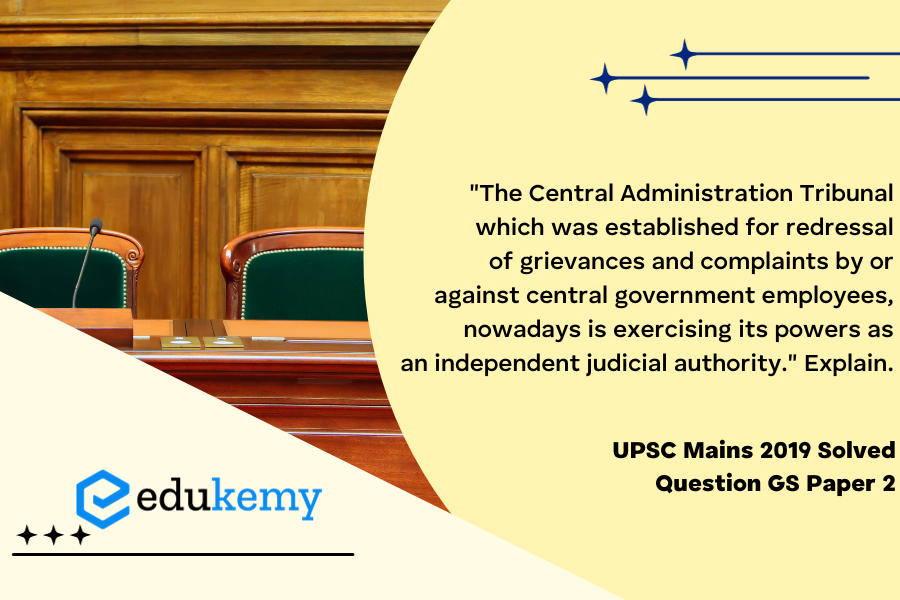The Central Administration Tribunal (CAT), instituted with the primary objective of addressing grievances and complaints lodged by or against employees of the central government, has evolved into a formidable and autonomous judicial authority in contemporary times. Established to provide a fair and expeditious mechanism for the resolution of disputes related to service matters, CAT has transcended its initial role as a mere administrative tribunal. Over the years, it has assumed the character of an independent judicial entity, wielding substantial powers to adjudicate on a broad spectrum of issues affecting central government employees.
Tag: Statutory, regulatory, and various quasi-judicial bodies.
Contents
Decoding the Question:
- In the Introduction, try to briefly write about the Central Administration Tribunal.
- In Body, discuss the powers and functions exercised by CAT.
- In Conclusion, try to write the significance of the Central Administration Tribunal.
Answer:
The 42nd Amendment Act of 1976 added a new Part XIV-A to the Constitution, which is titled ‘Tribunals’ and consists of Article 323A, which empowers the Parliament to provide for the establishment of administrative tribunals for the adjudication of disputes relating to recruitment and conditions of service of public servants. The Central Administrative Tribunal (CAT) was established by an Act of 1985. The Principal seat of CAT is in New Delhi with additional benches in different states. The CAT has been given original jurisdiction over recruitment and all service matters of public servants covered by it.
Composition of Central Administration Tribunal:
- It is a multi-member body consisting of a Chairman and members; the members were given the status of judges of High Courts in 2006.
- The members are drawn from both judicial and administrative streams and are appointed by the President.
- The members hold office for a term of five years or until they attain the age of 65 years, in the case of the Chairman and 62 years in the case of members, whichever is earlier.

Powers and Functions of Central Administration Tribunal:
- Article 323A enables the Parliament to take out the adjudication of disputes relating to service matters from the civil courts and the high courts and place it before the administrative tribunals.
- Its jurisdiction extends to the All-India Services, the Central civil services, civil posts under the Centre, and civilian employees of defense services.
- CAT is free from the technical rules of the Indian Evidence Act, 1872, and procedural shackles of the Code of Civil Procedure, 1908 but it has been vested with the powers of the Civil Court in respect of some matters including the review of their own decisions and are bound by the principles of natural justice.
- The Delhi High Court has held that the Central Administrative Tribunal (CAT), which adjudicates service matters, can exercise the same jurisdiction and powers as a High Court in respect of its contempt proceedings.
- Earlier the decision of the Tribunal can be challenged only before the Supreme Court by filing a Special leave petition, but after the Chandra Kumar case, the orders of CAT can now be challenged by way of a writ petition (Article 226 & 227) before the respective High courts.
- The case lays down that appeals against the orders of the Tribunal shall lie before the division bench of the concerned High Court.
However, the Central Administrative Tribunal still cannot be called a truly independent judicial body because:
- The Tribunal members do not enjoy powers like other judges who hold constitutional posts, and
- It is dependent on the executive for appointing members of the tribunal and their funding.
Thus, it can be fairly argued that the tribunal which was formed for grievance and complaints redressal has evolved into a judicial body but it cannot be called entirely independent.
In case you still have your doubts, contact us on 9811333901.
For UPSC Prelims Resources, Click here
For Daily Updates and Study Material:
Join our Telegram Channel – Edukemy for IAS
- 1. Learn through Videos – here
- 2. Be Exam Ready by Practicing Daily MCQs – here
- 3. Daily Newsletter – Get all your Current Affairs Covered – here
- 4. Mains Answer Writing Practice – here


